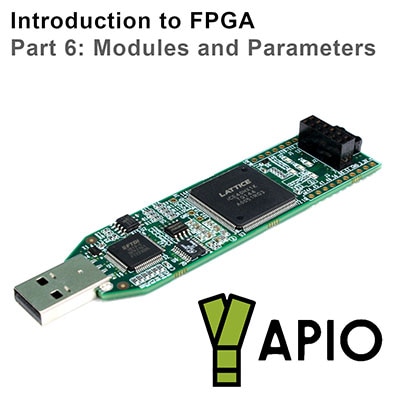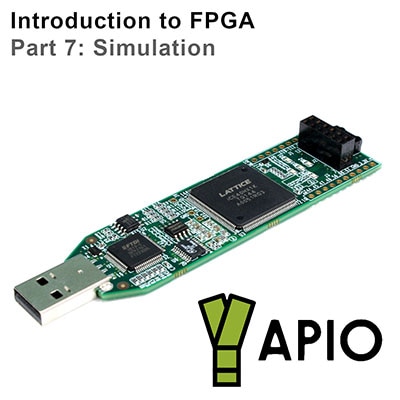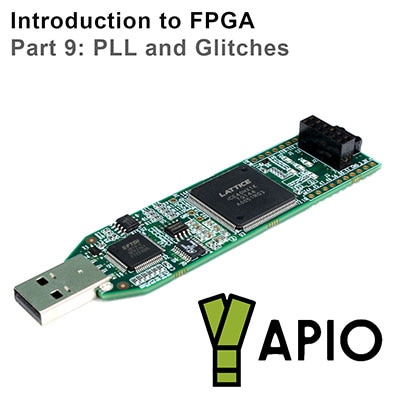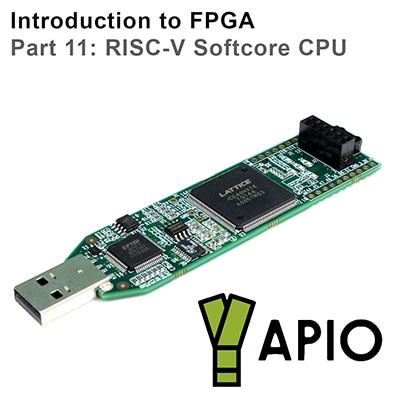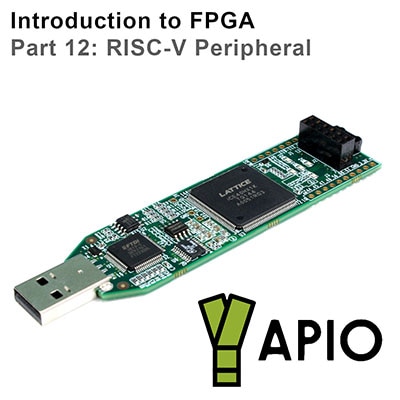Introduction to FPGA Part 10 - Metastability and FIFO
2022-01-17 | By ShawnHymel
License: Attribution
A field-programmable gate array (FPGA) is a reconfigurable integrated circuit (IC) that lets you implement a wide range of custom digital circuits. Throughout the series, we will examine how an FPGA works as well as demonstrate the basic building blocks of implementing digital circuits using the Verilog hardware description language (HDL).
When a signal is sampled on a D flip-flop, it must maintain its value for some period of time before the clock transition (setup time) and some time after (hold time). If the input signal changes during one of these windows, it is considered a violation, and metastability could occur.
During a metastable event, the output of the flip-flop is in an unknown state for an indeterminate amount of time. Usually, the output settles on logic high or logic low in a matter of nanoseconds, but the unknown state could, in theory, last forever.
In the previous tutorial, we showed how faster clock speeds can introduce glitches. In this tutorial, we demonstrate a FIFO design that is resilient to metastability and can be used with asynchronous signals or across clock domains.
Video
If you have not done so, please watch the following video, which explains the concepts required to complete the challenge. It also demonstrates a working version of the challenge:
Required Hardware
You will need only the Icarus Verilog simulator and GTKWave waveform viewer for this challenge, as you will be required to simulate gate delays to prove that your design reduces glitches.
Resources
The following datasheets and guides might be helpful as you tackle the challenges:
GitHub repository - contains all examples and solutions for this series
Challenge
As shown in the video, metastability can occur if a setup or hold time violation occurs. This type of anomaly is prevalent when working with asynchronous signals (e.g. signals that are not clocked) or with signals from another clock domain (e.g. signals that are not clocked on the same system clock). You can see metastability in action in this blog post by Colin O’Flynn.
To keep things simple, it’s often advised that FPGA designers should only work with synchronous signals and use one clock for the entire design (or a divided version of the same clock). However, sometimes you must work across clock domains. For example, if you have another device talking to your FPGA over SPI that drives the clock (SCK) line. If the SCK line toggles at 5 MHz and the FPGA clock toggles at 12 MHz, then we must cross clock domains.
One of the most common techniques for working across clock domains is to use a “synchronizer” circuit. This includes a chain of 2 or more flip-flops that operate on the receiving clock signal. You can read more about the synchronizer here.
Additionally, some FPGA block RAM allows you to read and write using different clock signals. This is known as “dual-port RAM.” The block RAM in our iCE40-HX1K offers dual-port capabilities. We can use that to construct a first-in, first out (FIFO) system that allows us to pass data from one clock domain to another. This might include queuing up samples taken from a sensor or acting as a buffer for a communication system (e.g. SPI) that operates on a different clock domain.
Avoiding metastability in a FIFO can be quite difficult. As a result, it often helps to turn to the experts who have spent years perfecting such designs. One such FIFO design can be found here. Clifford Cummings has graciously provided us with a detailed design of his FIFO as well as Verilog code that we can implement.
Your challenge is to implement the FIFO outlined in the above paper, build a testbench for it, and test it with Icarus Verilog.
Solution
Spoilers below! I highly encourage you to try the challenge on your own before comparing your answer to mine. Note that my solution may not be the only way to solve the challenge.
Here is my implementation. Note that I combined some of the modules from Clifford Cummings’s paper, but the design should work the same.
async-fifo.v
// Asynchronous FIFO module
module async_fifo #(
// Parameters
parameter DATA_SIZE = 8, // Number of data bits
parameter ADDR_SIZE = 4 // Number of bits for address
) (
// Inputs
input [DATA_SIZE-1:0] w_data, // Data to be written to FIFO
input w_en, // Write data and increment addr.
input w_clk, // Write domain clock
input w_rst, // Write domain reset
input r_en, // Read data and increment addr.
input r_clk, // Read domain clock
input r_rst, // Read domain reset
// Outputs
output w_full, // Flag: 1 if FIFO is full
output reg [DATA_SIZE-1:0] r_data, // Data to be read from FIFO
output r_empty // Flag: 1 if FIFO is empty
);
// Constants
localparam FIFO_DEPTH = (1 << ADDR_SIZE);
// Internal signals
wire [ADDR_SIZE-1:0] w_addr;
wire [ADDR_SIZE:0] w_gray;
wire [ADDR_SIZE-1:0] r_addr;
wire [ADDR_SIZE:0] r_gray;
// Internal storage elements
reg [ADDR_SIZE:0] w_syn_r_gray;
reg [ADDR_SIZE:0] w_syn_r_gray_pipe;
reg [ADDR_SIZE:0] r_syn_w_gray;
reg [ADDR_SIZE:0] r_syn_w_gray_pipe;
// Declare memory
reg [DATA_SIZE-1:0] mem [0:FIFO_DEPTH-1];
//--------------------------------------------------------------------------
// Dual-port memory (should be inferred as block RAM)
// Write data logic for dual-port memory (separate write clock)
// Do not write if FIFO is full!
always @ (posedge w_clk) begin
if (w_en & ~w_full) begin
mem[w_addr] <= w_data;
end
end
// Read data logic for dual-port memory (separate read clock)
// Do not read if FIFO is empty!
always @ (posedge r_clk) begin
if (r_en & ~r_empty) begin
r_data <= mem[r_addr];
end
end
//--------------------------------------------------------------------------
// Synchronizer logic
// Pass read-domain Gray code pointer to write domain
always @ (posedge w_clk or posedge w_rst) begin
if (w_rst == 1'b1) begin
w_syn_r_gray_pipe <= 0;
w_syn_r_gray <= 0;
end else begin
w_syn_r_gray_pipe <= r_gray;
w_syn_r_gray <= w_syn_r_gray_pipe;
end
end
// Pass write-domain Gray code pointer to read domain
always @ (posedge r_clk or posedge r_rst) begin
if (r_rst == 1'b1) begin
r_syn_w_gray_pipe <= 0;
r_syn_w_gray <= 0;
end else begin
r_syn_w_gray_pipe <= w_gray;
r_syn_w_gray <= r_syn_w_gray_pipe;
end
end
//--------------------------------------------------------------------------
// Instantiate incrementer and full/empty checker modules
// Write address increment and full check module
w_ptr_full #(.ADDR_SIZE(ADDR_SIZE)) w_ptr_full (
.w_syn_r_gray(w_syn_r_gray),
.w_inc(w_en),
.w_clk(w_clk),
.w_rst(w_rst),
.w_addr(w_addr),
.w_gray(w_gray),
.w_full(w_full)
);
// Read address increment and empty check module
r_ptr_empty #(.ADDR_SIZE(ADDR_SIZE)) r_ptr_empty (
.r_syn_w_gray(r_syn_w_gray),
.r_inc(r_en),
.r_clk(r_clk),
.r_rst(r_rst),
.r_addr(r_addr),
.r_gray(r_gray),
.r_empty(r_empty)
);
endmoduler-ptr-empty.v
// Increment read address and check if FIFO is empty
module r_ptr_empty #(
// Parameters
parameter ADDR_SIZE = 4 // Number of bits for address
) (
// Inputs
input [ADDR_SIZE:0] r_syn_w_gray, // Synced write Gray pointer
input r_inc, // 1 to increment address
input r_clk, // Read domain clock
input r_rst, // Read domain reset
// Outputs
output [ADDR_SIZE-1:0] r_addr, // Mem address to read from
output reg [ADDR_SIZE:0] r_gray, // Gray address with +1 MSb
output reg r_empty // 1 if FIFO is empty
);
// Internal signals
wire [ADDR_SIZE:0] r_gray_next; // Gray code version of address
wire [ADDR_SIZE:0] r_bin_next; // Binary version of address
wire r_empty_val; // FIFO is empty
// Internal storage elements
reg [ADDR_SIZE:0] r_bin; // Registered binary address
// Drop extra most significant bit (MSb) for addressing into memory
assign r_addr = r_bin[ADDR_SIZE-1:0];
// Be ready with next (incremented) address (if inc set and not empty)
assign r_bin_next = r_bin + (r_inc & ~r_empty);
// Convert next binary address to Gray code value
assign r_gray_next = (r_bin_next >> 1) ^ r_bin_next;
// If the synced write Gray code is equal to the current read Gray code,
// then the pointers have caught up to each other and the FIFO is empty
assign r_empty_val = (r_gray_next == r_syn_w_gray);
// Register the binary and Gray code pointers in the read clock domain
always @ (posedge r_clk or posedge r_rst) begin
if (r_rst == 1'b1) begin
r_bin <= 0;
r_gray <= 0;
end else begin
r_bin <= r_bin_next;
r_gray <= r_gray_next;
end
end
// Register the empty flag
always @ (posedge r_clk or posedge r_rst) begin
if (r_rst == 1'b1) begin
r_empty <= 1'b1;
end else begin
r_empty <= r_empty_val;
end
end
endmodulew-ptr-full.v
// Increment write address and check if FIFO is full
module w_ptr_full #(
// Parameters
parameter ADDR_SIZE = 4 // Number of bits for address
) (
// Inputs
input [ADDR_SIZE:0] w_syn_r_gray, // Synced read Gray pointer
input w_inc, // 1 to increment address
input w_clk, // Write domain clock
input w_rst, // Write domain reset
// Outputs
output [ADDR_SIZE-1:0] w_addr, // Mem address to write to
output reg [ADDR_SIZE:0] w_gray, // Gray adress with +1 MSb
output reg w_full // 1 if FIFO is full
);
// Internal signals
wire [ADDR_SIZE:0] w_gray_next; // Gray code version of address
wire [ADDR_SIZE:0] w_bin_next; // Binary version of address
wire w_full_val; // FIFO is full
// Internal storage elements
reg [ADDR_SIZE:0] w_bin; // Registered binary address
// Drop extra most significant bit (MSb) for addressing into memory
assign w_addr = w_bin[ADDR_SIZE-1:0];
// Be ready with next (incremented) address (if inc set and not full)
assign w_bin_next = w_bin + (w_inc & ~w_full);
// Convert next binary address to Gray code value
assign w_gray_next = (w_bin_next >> 1) ^ w_bin_next;
// Compare write Gray code to synced read Gray code to see if FIFO is full
// If: extra MSb of read and write Gray codes are not equal AND
// 2nd MSb of read and write Gray codes are not equal AND
// the rest of the bits are equal
// Then: address pointers are same with write pointer ahead by 2^ADDR_SIZE
// elements (i.e. wrapped around), so FIFO is full.
assign w_full_val = ((w_gray_next[ADDR_SIZE] != w_syn_r_gray[ADDR_SIZE]) &&
(w_gray_next[ADDR_SIZE-1] != w_syn_r_gray[ADDR_SIZE-1]) &&
(w_gray_next[ADDR_SIZE-2:0] == w_syn_r_gray[ADDR_SIZE-2:0]));
// Register the binary and Gray code pointers in the write clock domain
always @ (posedge w_clk or posedge w_rst) begin
if (w_rst == 1'b1) begin
w_bin <= 0;
w_gray <= 0;
end else begin
w_bin <= w_bin_next;
w_gray <= w_gray_next;
end
end
// Register the full flag
always @ (posedge w_clk or posedge w_rst) begin
if (w_rst == 1'b1) begin
w_full <= 1'b0;
end else begin
w_full <= w_full_val;
end
end
endmoduleHere is my testbench:
async-fifo_tb.v
// Define timescale
`timescale 1 us / 10 ps
// Define our testbench
module async_fifo_tb();
// Settings
localparam DATA_SIZE = 8;
localparam ADDR_SIZE = 4;
// Internal signals
wire [DATA_SIZE-1:0] r_data;
wire r_empty;
wire r_full;
// Internal storage elements
reg r_en = 0;
reg r_clk = 0;
reg r_rst = 0;
reg [DATA_SIZE-1:0] w_data;
reg w_en = 0;
reg w_clk = 0;
reg w_rst = 0;
// Variables
integer i;
// Simulation time: 10000 * 1 us = 10 ms
localparam DURATION = 10000;
// Generate read clock signal (about 12 MHz)
always begin
#0.04167
r_clk = ~r_clk;
end
// Generate write clock signal (5 MHz)
always begin
#0.1
w_clk = ~w_clk;
end
// Instantiate FIFO
async_fifo #(
.DATA_SIZE(DATA_SIZE),
.ADDR_SIZE(ADDR_SIZE)
) uut (
.w_data(w_data),
.w_en(w_en),
.w_clk(w_clk),
.w_rst(w_rst),
.r_en(r_en),
.r_clk(r_clk),
.r_rst(r_rst),
.w_full(w_full),
.r_data(r_data),
.r_empty(r_empty)
);
// Test control: write and read data to/from FIFO
initial begin
// Pulse resets high to initialize memory and counters
#0.1
w_rst = 1;
r_rst = 1;
#0.01
w_rst = 0;
r_rst = 0;
// Write some data to the FIFO
for (i = 0; i < 4; i = i + 1) begin
#0.2
w_data = i;
w_en = 1'b1;
end
#0.2
w_en = 1'b0;
// Try to read more than what's in the FIFO
for (i = 0; i < 6; i = i + 1) begin
#0.08334
r_en = 1'b1;
end
#0.08334
r_en = 1'b0;
// Fill up FIFO (and then some)
for (i = 0; i < 18; i = i + 1) begin
#0.2
w_en = 1'b1;
w_data = i;
end
#0.2
w_en = 1'b0;
// Read everything in the FIFO (and then some)
for (i = 0; i < 18; i = i + 1) begin
#0.08334
r_en = 1'b1;
end
#0.08334
r_en = 1'b0;
end
// Run simulation
initial begin
// Create simulation output file
$dumpfile("async-fifo_tb.vcd");
$dumpvars(0, async_fifo_tb);
// Wait for given amount of time for simulation to complete
#(DURATION)
// Notify and end simulation
$display("Finished!");
$finish;
end
endmoduleWhen I simulate the design, you can see how data is read in the same order in which it was placed into the FIFO.
Additionally, the w_full line goes high when the FIFO is full (all the memory elements are filled with data) and the r_empty line goes high when the FIFO is empty (no data left to read). The internal circuitry prevents reading when empty and writing when full, so the lines mostly act as indicators to your other modules (if you want to know when to stop reading or writing).
Recommended Reading
The following content might be helpful if you would like to dig deeper:
Introduction to FPGA Part 4 - Clocks and Procedural Assignments
Introduction to FPGA Part 6 - Verilog Modules and Parameters
Introduction to FPGA Part 7 - Verilog Testbenches and Simulation
Introduction to FPGA Part 9 - Phase-Locked Loop (PLL) and Glitches











